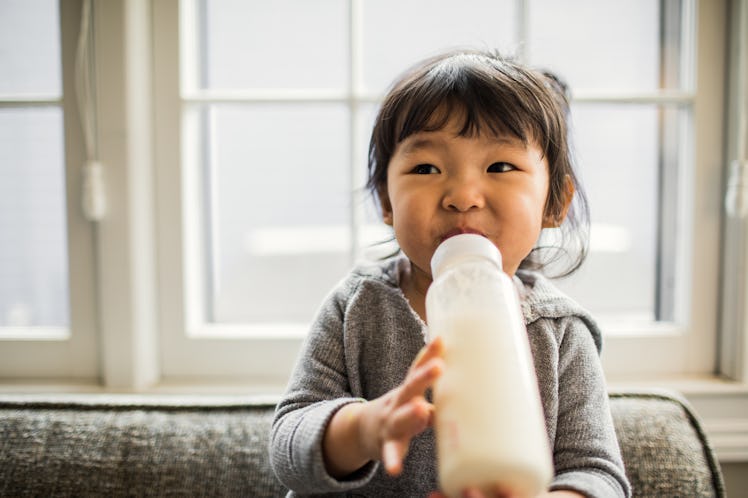How To Wean Your Toddler Off Their Baby Bottle
Getting off the bottle is a big kid move, and knowing that may make it easier for your kid.

It’s not surprising that your toddler is so attached to their baby bottle. After all, it makes the hunger go away. And if they’re drinking it at night, not only is the nourishment soothing, but the sucking is too.
But there are health concerns with kids older than 14 months continuing to use a bottle. That’s because this is also a time when they have started eating a more varied diet that includes solid food. So the calories from milk that were a staple of their diet become unneeded extra calories.
One study conducted by the American Academy of Pediatrics entitled the Early Childhood Longitudinal Study showed that many children were still using the bottle after 2-years-old. Those children were far more likely to be obese up to three years later compared to those who’d given up the bottle earlier. It’s just like how you drop the pounds during sober January.
More than that, sleeping with the bottle can be a serious issue. Not only does it not allow a child to learn how to self-soothe when they wake up at night, but it increases the chance for tooth decay. That’s because milk is full of natural sugars that bacteria thrive on.
How To Drop The Baby Bottle
First off, this isn’t going to be easy. Expect some tears and struggles.
Consider The Cup
Before you do anything, you’ll want to make sure your kid has something else to drink out of. Just doing this might be enough to get your kid to start thinking about moving away from the bottle. Here are some ways to give the cup some added allure:
- Let your kid pick it out.
- Help them understand cups are a big-kid move.
- Give them an opportunity to decorate it.
- Create some kind of cup transition ritual. Songs and dances are highly encouraged.
Once you have the cup in place you’ll need some strategies to make things just a tiny bit better for you as you go through this transition.
Keep The Bottle, Ditch The Milk
One of the more gentle (and frankly pretty sneaky) ways to deal with the issue is to manage the biggest bottle issue: the milk.
In this method, you transition the milk to a more appropriate cup. This milk is made additionally special by adding a little food coloring. Once your kid is cool with the cup, begin watering down the milk in the bottle while decreasing the color of the milk in the cup. It’ll take a while, but once you’re done, the bottle will be filled with water and your cup filled with milk. Like some amazing magic trick that takes a month. And honestly? Who cares if your kid is hitting a bottle of water all day and night?
The Gradual Bottle Fade
Another popular method is to slowly reduce the number of times your kid is getting their bottle during the day. The key to this strategy is to take away the bottle your kid is likely to miss least — which is probably the midday bottle. These bottles are replaced with milk in their special cup.
Additionally, the bottle can be restricted to specific times and places. Just like you’re not allowed to hit the bottle at work. Slowly you’ll take away all the bottles except for the one used at bedtime. That’s because the bedtime bottle is often part of the larger ritual. Now it’s time to start watering down the milk. Eventually, your kid will realize the milk in the cup is better and move away from the bottle. That’s the plan, anyway.
Cold Turkey
You might not think going cold turkey would require a process, but it does. Before removing the bottle from your home, talk with your kid about it before it actually goes down. Pair this with a cup shopping trip and any other big-kid ritual you dream up (short of helping them look for their own apartment).
When the time comes to remove the bottles, make sure your kid understands they are physically no longer there. You can give them a send-off if you think it won’t be too freaky. No Viking funerals.
In the end, the cold turkey method will require you to grit your teeth and dig in your heels. If you lose your nerve, minimize the ruckus by offering rewards for the bottle-free time. In the end, your bottle-free kid will be better for it. They may not know it (and they’re probably not going to write some intense, clear-eyed memoir), but at least there will be one more milestone down.
This article was originally published on